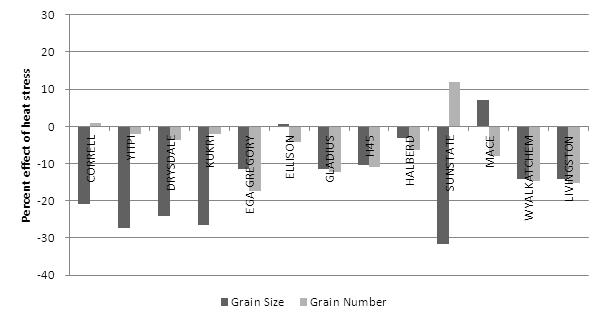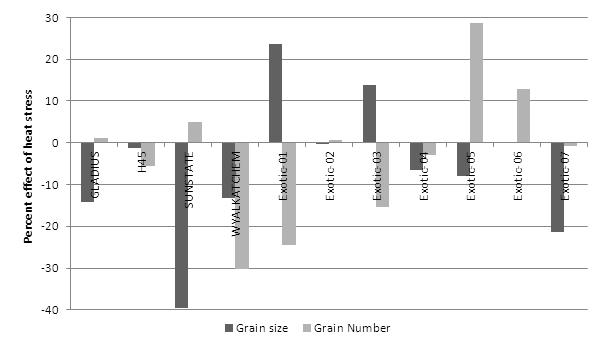Heat stress tolerance of wheat
Heat stress tolerance of wheat
Author: Paul Telfer, James Edwards, Haydn Kuchel, Jason Reinheimer and Dion Bennett | Date: 07 Feb 2013
Paul Telfer, James Edwards, Haydn Kuchel, Jason Reinheimer and Dion Bennett,
Australian Grain Technologies (AGT)
GRDC project code: This project has been partly funded by the GRDC
Take home messages
- Heat is a key abiotic stress. The effects of heat on grain yield are equally as important as drought and frost.
- Better adapted varieties also generally perform better in heat stress conditions, especially varieties from Southern Australia.
Introduction
Heat stress is a key abiotic stress affecting crop and cereal production in all regions of the Australian wheat belt. Heat stress can have significant effects on grain yield and productivity, with potential losses equal to and potentially greater than other abiotic stress such as drought and frost. Controlled environment studies have established that a 3-5% reduction in grain yield of wheat can occur for every one degree increase in average temperature above 15°C (Gibson and Paulsen, 1999). Field data suggests that yield losses can be in the order of 190 kg/ha for every one degree rise in average temperature and in some situations having a more serve effect on yield loss than water availability (Kuchel et al. 2007; Bennett et al. 2012).
The reproductive stages of growth have greater sensitivity to elevated temperatures, with physiological responses including premature leaf senescence, reduced photosynthetic rate, reduced seed set, reduced duration of grain fill, reduced grain size, all ultimately leading to reduced grain yield (Stone and Nicolas, 1995). Such elevated temperatures are a normal, largely unavoidable occurrence during the reproductive phase of Australian crops in September and October. For example at Roseworthy in 2012 there were 10 days over 30°C and two days over 35°C during this period.
Current research
There are two research projects being undertaken by AGT, with funding assistance from the South Australian Grains Industry Trust (SAGIT) and the GRDC. The SAGIT funded project involves using a controlled environment assay that is run at Roseworthy, to identify and quantify the level of heat stress tolerance in current varieties, advanced breeders lines and exotic lines, as well as using ’gene mapping’, to genetically dissect and understand the key sources of tolerance identified to date. In addition to this, Multi Environment Trial (MET) and multi variate analyses are used to quantify the relationship between field performance and the controlled environment, of common varieties and AGT advanced breeders lines. The GRDC project involves running experiments in the managed environment facilities (MEF) at Narrabri, Yanco and Merredin, with the aim of further field validation of observed heat stress tolerance from the controlled environment assay and to phenotype responses to heat stress in the field over a range of environments.
What is the impact of heat stress on grain yield?
Previous studies have quantified the effect of heat stress on grain yield, within specific ‘gene mapping’ populations (Kuchel et al. 2007; Bennett et al. 2012). To improve our understanding of heat stress tolerance an initial component of the SAGIT heat stress project expanded on these previous studies by analysing a broader range of wheat germplasm. This analysis of the average grain yield from the National Variety Trials (NVT) during 2005 to 2010 included over 600 experiment by year combinations and used climatic data from the nearest Australian Bureau of Meteorology weather station for each experiment. Data on climatic variables for each trial was kindly provided by Dr Scott Chapman and Dr Bangyou Zheng, CSIRO Plant Industry. This study illustrated that high temperatures have a highly significant (P<0.001) negative effect on grain yield, particularly in the flowering growth stage (Table 1). Each millimetre of rainfall received during flowering and the grain filling periods resulted in an increase in grain yield of 22 kg/ha (similar to what the Finlay-Wilkinson model predicts), whilst the impact of hotter than average temperatures and the number of ‘hot’ (>30 oC) and ‘very hot’ (>40 oC) days resulted in significantly (P<0.001) lower grain yields.
Table 1. The effect of various climatic variables on grain yield across over 600 field experiments in southern Australia 2005-2010. The average grain yield across all trials was 2530 kg/ha.
|
Growth Stage |
Climatic variable |
Unit |
Effect (kg/ha) |
|---|---|---|---|
|
Flowering |
Rainfall |
mm |
22 |
|
Average daily minimum temperature |
oC |
-161 |
|
|
Average daily maximum temperature |
oC |
-371 |
|
|
Days >30 oC |
number |
-379 |
|
|
Average Temperature |
oC |
-490 |
|
|
Days >35 oC |
number |
-837 |
|
|
|
|||
|
Grain filling |
Rainfall |
mm |
23 |
|
Average daily minimum |
oC |
-125 |
|
|
Days >30 oC |
number |
-130 |
|
|
Days >35 oC |
number |
-179 |
|
|
Average daily maximum |
oC |
-225 |
|
|
Average Temperature |
oC |
-244 |
Controlled environment experiments - what has been found to date?
Controlled environment experiments conducted at Roseworthy involve heat stressing plants 10 days after the main tillers finish anthesis at 36°C with 40 km hour-1 winds for three consecutive eight hour days. Sufficient watering removed any confounding effects from drought stress. Heat stressed plants are then compared to non heat treated control plants. This approach has been used to screen a large group of varieties and AGT advanced breeders lines, existing ’gene mapping’ populations, and exotic introductions. A large range of variation for heat stress tolerance has been found within the material screened. Among the phenotypic traits measured, the ability to maintain grain number and grain size have been found to be the most significant traits in terms of both plant response to heat stress and correlation with grain yield in field trials. Figure 1 illustrates the fertility and grain size response for a subset of varieties to heat stress in the controlled environment assay. In general heat stress causes a significant (p<0.05) reduction in both grain number and grain size, the two key yield components and therefore ultimately grain yield. However, there is variation in these traits, with some varieties being able to retain either grain number, or grain size after stress conditions. There is the potential to combine the positive effects of both grain number and grain size to improve heat stress tolerance in future varieties.
Assessing exotic introductions from regions around the world, that experience heat stress conditions, provides the potential to find new sources of genetic variation for heat stress tolerance. Variation has been found within the exotic introductions screened as illustrated by Figure 2, with large positive responses to both grain number and grain size. Crosses have been made, and production of ‘gene mapping’ populations from contrasting lines is currently underway. This study aims to identify and characterise new sources of genetic variation, determine if such traits have any associated deleterious effects, develop selection tools and potentially cross improved levels of tolerance into adapted germplasm. Screening of more exotic introductions is still in progress, to find further sources of genetic variation.

Figure 1. A subset of varieties showing their performance under heat stress conditions in the controlled environment assay.

Figure 2. A subset of exotic introductions that have been screened for heat stress tolerance in the controlled environment assay, showing diverse levels of adaptation.
The managed environment facilities (MEF) experiments
The MEF sites are funded by the GRDC to facilitate detailed phenotyping experiments in relevant, well characterized field environments with the ability to either induce or reduce drought stress using rain out shelters and irrigation. The three MEF sites are situated at Merredin in WA, managed by DAFWA, Narrabri, managed by Sydney University, and in Yanco, managed by NSW DPI. Rebetzke et al. (2012) describes the MEF sites and principles involved in more detail. The heat shock experiments at the MEF sites use a later sowing time to increase the exposure to heat stress conditions. These experiments are irrigated to reduce any confounding effects from drought. At Merredin (WA), rainout shelters, with the ends shut off, are also used to amplify temperatures. Experiments have detailed phenotypic observations taken and this information is subsequently related to the severity and frequency of heat stress events during the reproductive phases of plant growth. The overall aim of these experiments is to validate the results from the controlled environment assay. Initial results confirm an increase in average maximum temperature has a significant negative effect on grain yield. However, individual genotype evaluation is still a work in progress, and we are looking forward to evaluating the 2012 results.
How this information can be used
The screening of varieties has identified significant variation for heat stress tolerance. Due to the complexity of heat stress tolerance, the accuracy of the information generated in the initial stage of this project is not suitable as a variety selection tool. However, it can be used to further understand varietal adaptation and should be considered as a part of a holistic approach to crop management. Current varieties that are widely grown due to good general adaptation, also generally perform better under heat stress conditions. This is especially the case for varieties from the southern region of the Australian wheat belt.
It should also be noted that current agronomic management practices also contribute to the management of heat stress conditions. For example, insuring that the flowering times of varieties are correctly matched to the sowing window will reduce the risk of exposure to heat stress events during the sensitive reproductive growth stages, a similar approach to that used to avoid frost damage.
Looking to the future
A thorough understanding of the level of heat stress tolerance available in current varieties and the traits conferring tolerance has been achieved through the screening of current varieties and advanced breeders lines under controlled conditions. The next stage is to gain a greater understanding of the genetics, using purposely designed ‘gene mapping’ populations. The parents of these populations include current varieties, as well as exotic introductions, with the hope of finding new genetic sources of heat stress tolerance and to ultimately identify genetic markers that can be used for selection within breeding programs.
Acknowledgments
Acknowledgment goes to SAGIT and the GRDC for funding the projects.
References
Bennett D, Izanloo A, Reynolds M, Kuchel H, Langridge P, Schnurbusch T. (2012) Genetic dissection of grain yield and physical grain quality in bread wheat (Triticum aestiumL.) under water-limited environments. Theoretical and Applied Genetics 125:255–271.
Gibson LR, Paulsen GM (1999) Yield components of wheat grown under high temperature stress during reproductive growth. Crop Science 39:1841-1846.
Kuchel H, Williams K, Langridge P, Eagles HA, Jefferies SP (2007) Genetic dissection of grain yield in bread wheat. II. QTL-by-environment interaction. Theoretical and Applied Genetics 115:1015-1027.
Rebetzke Greg J., Chenu Karine, Biddulph Ben, Moeller Carina, Deery Dave M., Rattey Allan R., Bennett Dion, Barrett-Lennard Ed G., Mayer Jorge E. (2012) A multisite managed environment facility for targeted trait and germplasm phenotyping. Functional Plant Biology 40, 1–13.
Stone PJ, Nicolas ME (1995) A survey of the effects of high temperature during grain filling on yield and quality of 75 wheat cultivars. Australian Journal of Agricultural Research 46 , 475–492.
Contact details
Paul Telfer
Australian Grain Technologies
Perkins Building, Roseworthy Campus Roseworthy, South Australia 5371
paul.telfer@ausgraintech.com
